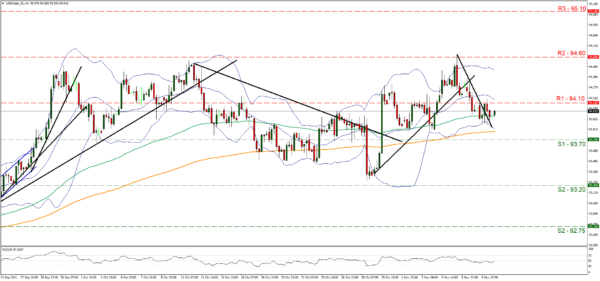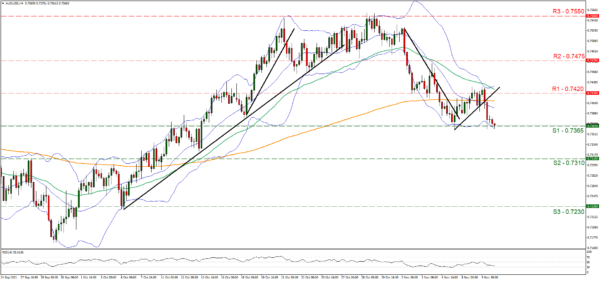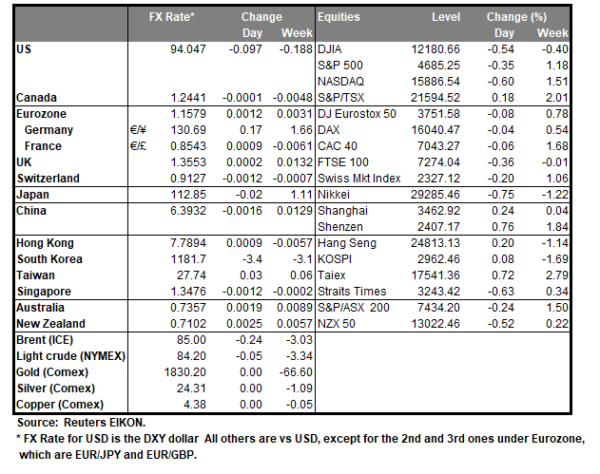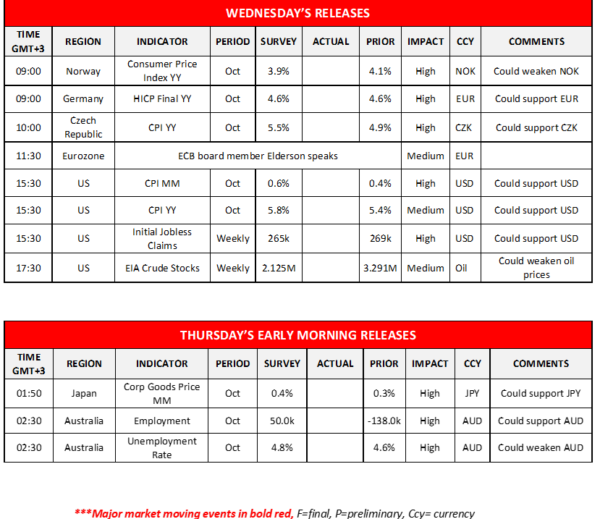The USD seems to have stabilised somewhat against a number of its counterparts yesterday, ahead of the release of the US CPI rates for October later today in the American session. Should the rates accelerate as forecasted we may see the headline rate reaching an over 20 year high as the rate has not seen such levels on a year-on-year level since the end of 1990, which in turn could increase the pressure on the Fed to tighten its monetary policy faster. Supply shortages in conjunction with an acceleration of the US wage growth rates for October tend to tilt the risks related to the release to the upside, while slowing consumption for September could moderate them. Also, we get from the US the weekly initial jobless claims figure which could provide some support for the USD if it drops further, while the two releases are to be simultaneous and could magnify the effect on the greenback under certain conditions.
The USD Index seems to have stabilised yesterday just below the 94.10 (R1) resistance line. As the index’s price action has broken the downward trendline guiding it we switch our bearish outlook in favour of a bias for a sideways movement. The RSI indicator below our 4-hour chart seems to remain near but below the reading of 50, which may imply a rather indecisive market. Should the bulls manage to take over and complete the reversal we may see the index breaking the 94.10 (R1) resistance line and aim for the 94.60 (R2) level that was tested on the 5th of November. Should the bears regain the momentum, we may see the index breaking the 93.70 (S1) support line and aim for the 93.20 (S2) support level.
AUD traders keep an eye out for October’s employment data
The Aussie lost considerable ground against the USD yesterday and during today’s Asian session, breaking an upward movement of the past two days and the sentiment seems to be quite bearish. We highlight the release of Australia’s employment data for October during Thursday’s Asian session, as the main release of the week for Aussie traders which could create considerable volatility for AUD pairs. Despite some tightening of the Australian employment market given the projected rise of the employment change figure, the expected rise of the unemployment rate may intensify the bearish appetite for the Aussie as the Australian employment market despite improving somewhat, seems to remain loose, which in turn could allow RBA to maintain its dovishness. It should be noted that the bank had pushed back against any idea of an earlier hiking of its interest rates in its latest meeting.
AUD/USD has been dropping since yesterday and is now testing the 0.7365 (S1) support line. We see the case for the downward movement to continue and a downward trendline to be formed. Please note that the RSI indicator below our 4-hour chart is near the reading of 30 underscoring the strength of the bearish sentiment. On the other hand the price action seems to be teasing the lower Bollinger band which may imply that a correction higher could be in the cards for the pair. Should the market continue to display a selling interest for AUD/USD we may see it breaking the 0.7365 (S1) line and aim if not break also for the 0.7310 (S2) support level. Should buyers take over we may see the pair reversing course and take aim for the 0.7420 (R1) resistance line and if broken the way would be paved for the 0.7475 (R2) resistance hurdle.
Today’s events and expectations
Today in the European session we get from Norway the Consumer Price Index, from Germany the final HICP rate and from the Czech Republic the CPI rates, all being for the month of October. On the monetary front please note that ECB board member Elderson speaks. In the American session, we get from the US, the CPI rates for October, the weekly initial jobless claims figure and the weekly EIA crude oil inventories figure. During Thursday’s Asian session we note the release of Japan’s corporate goods prices growth rate for October and Australia’s employment data for the same month.
Support: 93.70 (S1), 93.20 (S2), 92.75 (S3)
Resistance: 94.10 (R1), 94.60 (R2), 95.10 (R3)
Support: 0.7365 (S1), 0.7310 (S2), 0.7230 (S3)
Resistance: 0.7420 (R1), 0.7475 (R2), 0.7550 (R3)



















